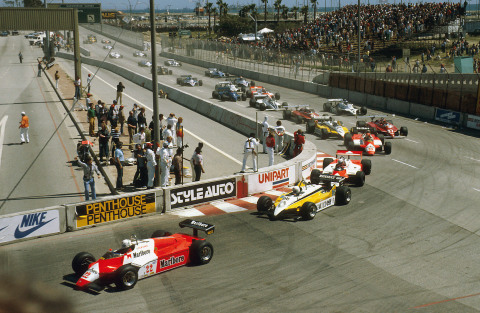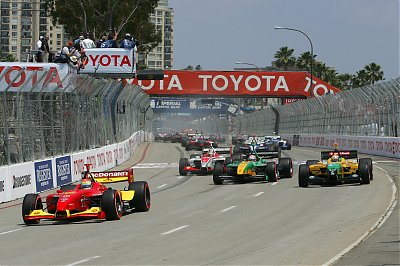The Way It Is/ Thirty-five years of street racing in Long Beach
by Gordon Kirby Next weekend sees the 35th running of the Long Beach Grand Prix, America's classic street race. This year the IRL's non-turbo Indy cars race for the first time in the California streets accompanied on Saturday by the ALMS cars making their third appearance at Long Beach. The IRL becomes the fifth series to lead Long Beach's weekend of races. The debut race in September of 1975 was for Formula 5000 cars, of course, sanctioned by the SCCA. Formula One took over for the following nine years through 1983, followed by CART for a twenty-year stretch from 1984-2003 and Champ Car for five races from 2004 through last year.
Next weekend sees the 35th running of the Long Beach Grand Prix, America's classic street race. This year the IRL's non-turbo Indy cars race for the first time in the California streets accompanied on Saturday by the ALMS cars making their third appearance at Long Beach. The IRL becomes the fifth series to lead Long Beach's weekend of races. The debut race in September of 1975 was for Formula 5000 cars, of course, sanctioned by the SCCA. Formula One took over for the following nine years through 1983, followed by CART for a twenty-year stretch from 1984-2003 and Champ Car for five races from 2004 through last year.
Long Beach has had its ups and downs. Founder Chris Pook was struggling to pay his bills when Mario Andretti gave the race a big push by winning the race aboard a Lotus in 1977, then taking the World Championship the following year. Crowds and overall interest boomed during Andretti's F1 heyday but Pook still couldn't afford Bernie Ecclestone's extortionate fees and switched to CART in 1984.
Many people believed Indy cars wouldn't perform or draw big crowds in Long Beach, but in 1983 Mario Andretti had retired from F1 and returned to the USA to focus on Indy car racing with Newman/Haas Racing for the final twelve years of his epic open-wheel career. Mario won at Long Beach in 1984 and again in '85 and '87 with son Michael scoring the first Indy car win of his career in '86 following a tremendous battle with Al Unser Jr. Then, of course, Al Jr. went on a tear, winning four years in a row in Long Beach from 1988-'91 and adding two more wins in 1994 and '95 to become Long Beach's record six-time winner.

© LAT USA
Alex Zanardi scored a pair of spectacular Long Beach victories in 1997 and '98. Juan Montoya took his first Indy car win in only his third start in the series in '99. Paul Tracy scored his second, third and fourth Long Beach wins in 2000, '03 and '04. And Sebastien Bourdais put together three straight triumphs in the California streets from 2005-'07 before Will Power won last year's final Champ Car race at Long Beach.
As we all know the spectator count has steadily declined in recent years but with the California Speedway struggling to attract crowds the weekend by the coast in Long Beach still stands as the biggest motorsports event in Southern California. I've had the pleasure of covering all thirty-four Long Beach weekends and I'm looking forward with equal pleasure to the thirty-fifth rendition.
A highlight of the weekend this year will be the Road Racing Drivers Club dinner with Dan Gurney on Thursday evening. Dan was one of the USA's greatest drivers, winning in F1, Indy cars, Can-Am, long-distance sports cars, NASCAR and Trans-Am cars. He was also one of our greatest car builders, founding All American Racers in 1965 and producing the magnificent line of Eagle race cars through 1999 and the combination of Dan's two careers as a driver and car builder/team owner made him the most accomplished man in the history of American racing.
And too, Dan was pivotal to the creation of the Long Beach GP and to Chris Pook selling Bernie Ecclestone on the idea of racing F1 cars in the city's streets. Long Beach founder Pook says the race would not have happened without Dan's considerable support.
"Dan played a significant role in every part of making the race happen," Pook declared. "The politics, the whole thing, it was the power of Dan and his personality that made it happen. We were very lucky to have him."
When Pook started work on selling his improbable idea of running a grand prix race in the streets of Long Beach Dan was one of the first people he called and Dan attended many meetings in Long Beach with Pook.

© Paul Webb
When it came to dealing with the racing authorities in the United States and Europe, Dan was Pook's most important weapon. It was Dan who convinced both the Automobile Competition Committee of the United States (ACCUS)--the USA's FIA representative--and the FIA's circuits and safety committee to take serious looks at Long Beach.
"We got derailed by the ACCUS first time around and Dan called (Tom) Binford and convinced him to come to Long Beach," Pook recalled "When Dan got through with him Binford was more excited about it than anybody. That was the kind of energy Dan brought to it."
Dan also proved to be the key man in getting Pook's idea approved by the California state government. "We flew Dan and Evi into San Francisco to meet with the Coastal Commission and a couple of the younger guys were big fans," Pook said. "He very quickly won over the 'greens' on the staff. That could have been the show-stopper right there and it wasn't at all. It was all very positive."
Back in the summer and fall of 1975 Dan was among a small group of people who believed that both the Long Beach GP and Formula 5000 had big futures. They envisaged a combined oval and road racing series, much like CART would become ten years later. Everyone knew that Pook wanted to switch Long Beach to F1 in 1976, moving to its traditional spring date, but there were hopes that pressure from a team owners group called NAGPA (North American Grand Prix Association) could move the SCCA and USAC to new levels as far as the management and promotion of F5000. Dan was one of the founders of NAGPA, as he would be of CART a few years later, and Pook ran the organization for a brief tenure.
The last three F5000 races of 1975, all in California, attracted big fields. The traditional October CanAm sports car dates at Riverside and Laguna Seca had switched to F5000 and were preceded by the inaugural Long Beach GP street race at the end of September. Forty-six F5000 cars were entered for the first Long Beach race, including F1 stars Jody Scheckter, Tom Pryce and Chris Amon as well as fast-rising Englishman Tony Brise and all the F5000 regulars like Brian Redman, Mario Andretti, Al Unser Sr, Englishmen David Hobbs and Jackie Oliver, as well as Canadian Eppie Wietzes and Aussies Vern Schuppan and Warwick Brown. In a famous moment, Schuppan's Eagle was the first car to take to the racetrack for the opening practice session at Long Beach in September of 1975 and Dan's father John sang the national anthem prior to the start of the first Long Beach GP two days later. Dan was an extremely proud son that day.

© LAT USA
Schuppan gave the F5000 Eagle its best race of the year at Long Beach, finishing second behind Brian Redman. After the race Dan and Pook flew east to meet Bernie Ecclestone at the United States GP at Watkins Glen where they discussed running a second F1 race in America at Long Beach in the spring of 1976.
"Dan was there all the way through," Pook adds. "We went to see Ecclestone at Watkins Glen and Bernard had great respect for him. Dan helped a lot in getting Bernard convinced that this was a serious project. Even in our crisis days in 1977, he was there. He stepped up and wrote a check like many others. He never wavered."
During the eighties Toyota began to expand rapidly in the United States and Toyota become acquainted with Dan through its pro-celebrity race at Long Beach and subsequent longterm sponsorship of the California street race. As a result, Toyota hired Dan for its 'Oh what a feeling!' national advertising campaign which featured Dan leaping in midair and grinning widely. The ads were shot on Pine Avenue in Long Beach as Dan helped promote both Toyota and the Long Beach GP.
All American Racers also began to build and race Toyota GTU, GTO and then GTP cars, ultimately winning a record seventeen straight and twenty-one IMSA GTP races in total from 1991-'93 with the Eagle-Toyota mk III GTP car.
Gurney is a true racing purist whose life was forged in doing his own thing and searching for innovative ideas and techniques. The long line of Eagle race cars is a testament to his innovative spirit and it's equally true that Dan would love to see the return of multiple car builders and engine manufacturers to Indy car racing. He would prefer that the best teams built and raced their own cars and engines as AAR did in its heyday and as every regular reader knows I agree entirely with Gurney on these issues.
In closing I have to add that many people look forward to the turbo era returning to Indy car racing and Long Beach in 2012, hopefully with two or even three competing engine manufacturers. As we all know, if the sport is truly to thrive again it has to get back to the essence of the independent, innovative spirit that drove Dan Gurney to become America's greatest racing man.
Auto Racing ~ Gordon Kirby
Copyright 2009 ~ All Rights Reserved
Copyright 2009 ~ All Rights Reserved
Top of Page